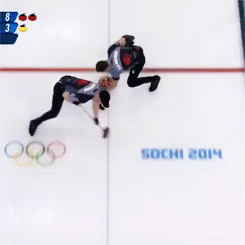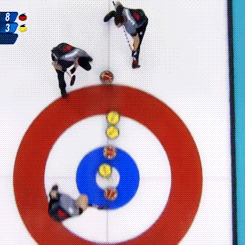The Sochi Winter Olympics: What is Curling?

February 24, 2014
Quality time with my treadmill consist of watching an intense sport that will most likely keep me entertained long enough to run until the game is over. Last week I decided to tune into The Sochi Winter Olympics. My ulterior motive was to learn something new about hockey, skiing or even ice skating. To my surprise, I was introduced to a Sport called Curling. My hopes of having an entertaining hour of running and yelling at my television became an hour of confusion and curiosity.
The Sochi Winter Olympics arena is packed with adoring fans. They cheer as if they are watching the last seconds of a tied NBA game. The curling competition begins and there are three men standing on an ice rink. Two of the men, are shuffling on the ice with objects that resemble Swiffer mops. Meanwhile, the other man looks violently focused on a big round rock. After watching a few minutes into the game, I was curious to know two things; what are they doing, and why are they doing it.
Before I began my search for some answers, I began to ask others the burning question. What is curling? Surprisingly enough I was not the only one unaware of the sport. Many students were baffled, some people had the impression it was a way maintenance prepping the ice for the next game. Others thought it was a weight training sport. The search for answers left me clueless.
The Sport of Curling originated from farmers in Scotland. The density of the game, and mental focus needed for a successful game, often described the game as chess on ice. It was the entertainment for many Scottish families as they collected stones from lakes with a flat surface to use for the competitive games on the ice. After stones were collected the wives of the competitors would prepare the stones with a brass handle. The highlight of brutal winters, were families gathering to watch the competitive game of Curling. The objective was to have the round stone smooth its way into the middle of the circle. The sound made by the round rock makes a roars as it curls its way into the bull’s eye.
Curling in the 20th century is a lot more complex. Today the game can be best described as a mixture of bowling and shuffleboard on ice. Unlike other sports played on ice, Curling is very unique. The sport relies heavily on physics and the transfer of momentum.

The simplest way to explain Curling can be found in a “Curling for Dummies” book. After reading and comprehending the objective of the game, my first impression changed from amusement to interest in the skill of the game. To help you better understand the game I will attempt to describe it in the simplest way possible.
The basic objective of the game is to have the stone as close to the center as possible. The round rocks that are pushed around are stones with a flat surface and have to be used wisely throughout the entire game. There is no such thing as curling without the stones. They are the make-up of the game. The stones are to create some sort of a wall to prevent the other teams from being able to reach the middle of the circle. Each game consists of ten “ends,” to better understand the terms you can think of it as innings in baseball.
In each end, each team member throws two stones, therefore all together throughout the entire game, the competitors have a total of 10 stones. If there is a tie after the ten ends, the game play continues until the tie is broken. Gameplay is typical reserved to 73 minutes per team. Each team is given 2 timeouts for each end. If extra ends are played, they are limited to 10 minutes per team with an extra time out.
The sweepers, which resemble Swiffer mops follow the stone while watching its speed to correctly guide the stone to an efficient angle. The friction from the sweeping creates thin water tracks that the stone can follow.
Training for Curling is no different than training for any other Olympic game. Lots of Athleticism and coordination in involved in the game. The most fascinating part of the game is the correlation of the physics and ice.
Curling made its first Olympic debut in the first winter Olympics of 1924. It did not become an exclusive sport until 1998. The sport has grown in popularity, and has been in every winter Olympic since. Canada has adopted that game and made it their own.




